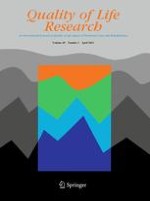01-04-2011
Associations between living arrangements and health-related quality of life of urban elderly people: a study from China
Gepubliceerd in: Quality of Life Research | Uitgave 3/2011
Log in om toegang te krijgenAbstract
Purpose
This study aimed to compare health-related quality of life (HRQOL) for elderly men and women in three mutually exclusive living arrangements: living alone, living only with spouse, and non-empty-nesters. It also examined whether such living arrangements and other factors relating to social interaction have an independent influence on HRQOL after controlling for other variables.
Methods
The data were drawn from China’s 4th National Household Health Survey (NHHS) conducted in 2008. The final sample included 9,711 urban elderly people of 60 years and above. The EQ-5D inventory was used to measure health-related quality of life.
Results
The proportions of non-empty-nested men and women both changed following a ‘U’-shaped curve with the increasing age. Controlling for other variables not including social interaction indicators, “living alone” was a significant predictor of reporting problems on Mobility, Pain/Discomfort and Anxiety/Depression. After introducing social interaction indicators, urban older adults ‘having close contact with neighbors every week’ had lower odds of problems on all five EQ-5D indicators, those ‘having close contact with friends and relatives’ had lower odds of problems on Mobility, Pain/Discomfort and Anxiety/Depression, and those ‘taking part in social activities every week’ had lower odds of problems on all dimensions but Anxiety/Depression. In addition, after introducing social interaction indicators, the odds of reported problems on the three dimensions increased obviously.
Conclusions
This study suggests that the most vulnerable urban older adults are those who live entirely on their own. Frequent social interaction may buffer the negative effect of living alone on HRQOL of older adults. Policies that attempt to build harmonious neighborhoods, extend older adults’ social network and encourage them to take part in social activities should be considered by the policy-makers in the future.
